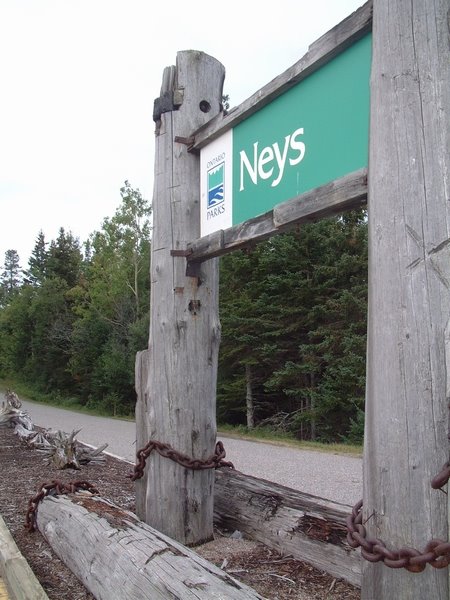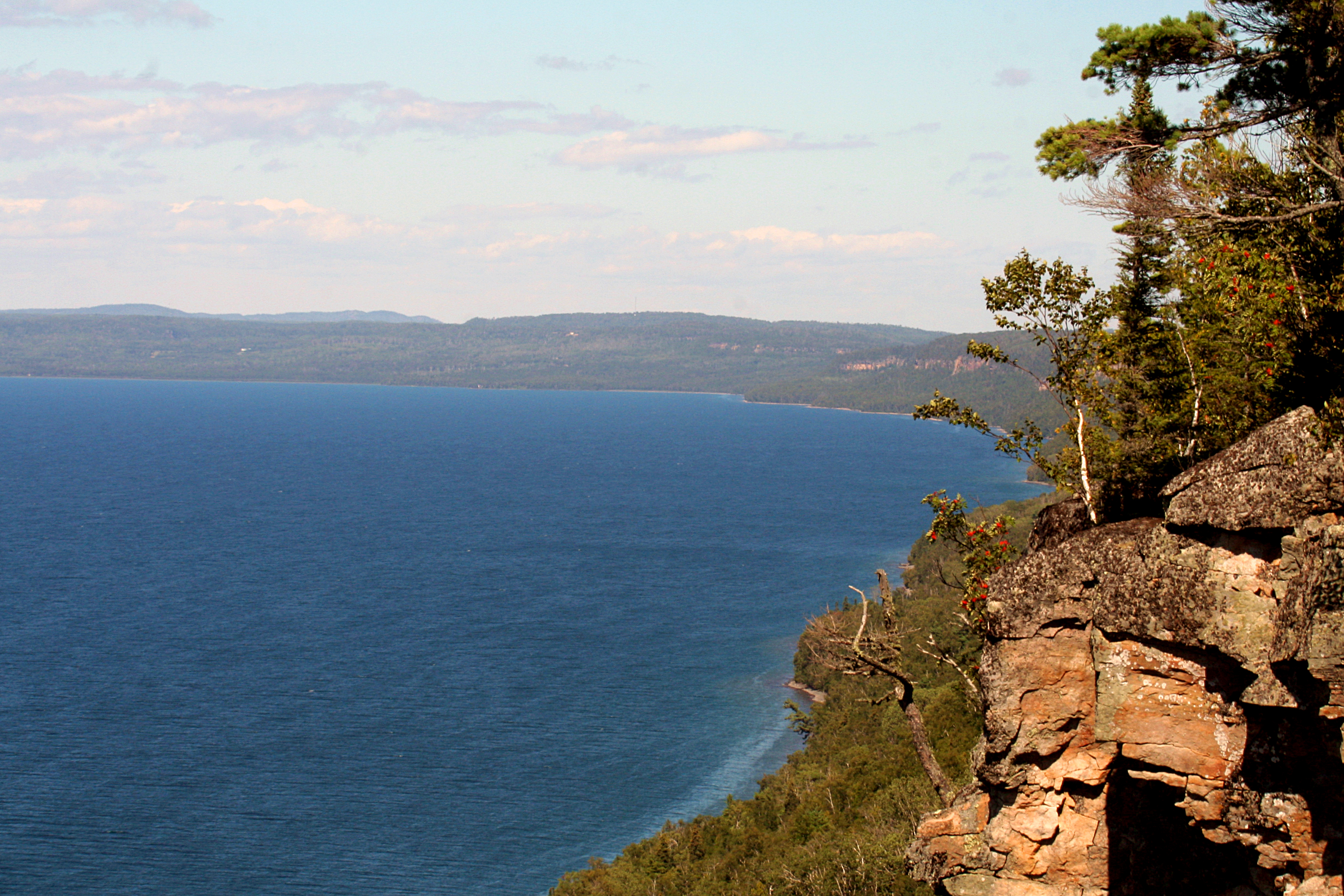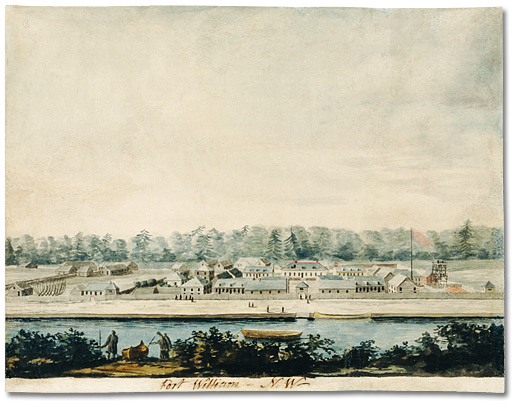|
Neys Provincial Park
Neys Provincial Park is a natural environment-class provincial park on the north shore of Lake Superior, just west of Marathon, Ontario, Canada. This park includes the historic Coldwell Peninsula and the surrounding island system (added as part of Ontario's Living Legacy in 2000–2001), consisting of Pic Island, Detention Island, and the Sullivan Islands. The ghost village of Coldwell, which lies just outside the park's east boundary, was home to an old railway and fishing community until the 1960s. All that remains of the village now are a few foundations, shipwrecks in the harbour and a cemetery. Within park boundaries is also the muse for Group of Seven (artists), Group of Seven member Lawren Harris, who in 1924 painted the now-famous image of Pic Island. Flora and fauna in the park include many hardy species of subarctic plants and a rare herd of Boreal woodland caribou, woodland caribou. The park is home to one of the most popular beaches on Lake Superior’s north shore a ... [...More Info...] [...Related Items...] OR: [Wikipedia] [Google] [Baidu] |
Thunder Bay District
Thunder Bay District is a district and census division in Northwestern Ontario in the Canadian province of Ontario. The district seat is Thunder Bay. In 2016, the population was 146,048. The land area is ; the population density was . Most of the district (93.5%) is unincorporated and part of the Unorganized Thunder Bay District. History Thunder Bay District was created in 1871 by provincial statute from the western half of Algoma District, named after a large bay on the north shore of Lake Superior. Its northern and western boundaries were uncertain until Ontario's right to Northwestern Ontario was determined by the Judicial Committee of the Privy Council. Until about 1902 it was often called Algoma West from the name of the provincial constituency established in 1885. The following districts include areas that were formerly part of Thunder Bay District: * Rainy River, created in 1885 * Kenora, created in 1907 from Rainy River District * Cochrane, created in 1921 Subdivisio ... [...More Info...] [...Related Items...] OR: [Wikipedia] [Google] [Baidu] |
Bowling Green State University
Bowling Green State University (BGSU) is a public research university in Bowling Green, Ohio. The main academic and residential campus is south of Toledo, Ohio. The university has nationally recognized programs and research facilities in the natural and social sciences, education, arts, business, health and wellness, humanities and applied technologies. The institution was granted a charter in 1910 as a normal school, specializing in teacher training and education, as part of the Lowry Normal School Bill that authorized two new normal schools in the state of Ohio. Over the university's history, it has developed from a small rural normal school into a comprehensive public research university. It is a part of University System of Ohio and classified among "R2: Doctoral Universities – High research activity". In 2019, Bowling Green offered over 200 undergraduate programs, as well as master's and doctoral degrees through eight academic colleges. BGSU had an on-campus resident ... [...More Info...] [...Related Items...] OR: [Wikipedia] [Google] [Baidu] |
Slate Islands
The Slate Islands are an island group in the Inner Hebrides, lying immediately off the west coast of Scotland, north of Jura and southwest of Oban. The main islands are Seil, Easdale, Luing, Shuna, Torsa and Belnahua. Scarba and Kerrera, which lie nearby are not usually included. The underlying geology of the islands is Dalradian slate, which was quarried widely until the mid-20th century. Quarry working began in 1630 and at the turn of the 20th century, the quarries were yielding some eight million slates every year. The Garvellachs lie to the southwest. Definition Unlike some of Scotland's larger archipelagos such as Orkney and the Outer Hebrides, which are distant from other islands and also have their own local authority, the Slate Islands have no formal definition. The islands from which the slate that gives rise to the name was quarried on a substantial commercial basis are Easdale, Belnahua, Luing and Seil. The website of the Slate Islands Heritage Trust also promin ... [...More Info...] [...Related Items...] OR: [Wikipedia] [Google] [Baidu] |
Log Boom
A log boom (sometimes called a log fence or log bag) is a barrier placed in a river, designed to collect and or contain floating logs timbered from nearby forests. The term is also used as a place where logs were collected into booms, as at the mouth of a river. With several firms driving on the same stream, it was necessary to direct the logs to their owner's respective booms, with each log identified by its own patented timber mark. One of the most well known logbooms was in Williamsport, Pennsylvania, along the Susquehanna River. The development and completion of that specific log boom in 1851 made Williamsport the "Lumber Capital of the World". As the logs proceeded downstream, they encountered these booms in a manner that allowed log drivers to control their progress, eventually guiding them to the river mouth or sawmills. Most importantly, the booms could be towed across lakes, like rafts, or anchored while individual logs awaited their turn to go through the mill. Booms ... [...More Info...] [...Related Items...] OR: [Wikipedia] [Google] [Baidu] |
Peavey (tool)
{{disambiguation ...
Peavey may refer to: * Peavey (surname) * Peavey (tool), a logging tool * Peavey Electronics, an American audio equipment manufacturer * Peavey Company, a former name of Gavilon, an American commodity management firm See also * Peavy (other) * * * Pee Vee (other) * Pee Wee (other) * PV (other) PV may refer to: Places * Paceville, Malta * Puerto Vallarta, Mexico * Postal village, a settlement that has a post office United States * Palos Verdes Peninsula, California * Prescott Valley, Arizona * Prairie Village, Kansas Politics * Par ... [...More Info...] [...Related Items...] OR: [Wikipedia] [Google] [Baidu] |
Canadian Pacific Railway
The Canadian Pacific Railway (french: Chemin de fer Canadien Pacifique) , also known simply as CPR or Canadian Pacific and formerly as CP Rail (1968–1996), is a Canadian Class I railway incorporated in 1881. The railway is owned by Canadian Pacific Railway Limited, which began operations as legal owner in a corporate restructuring in 2001. Headquartered in Calgary, Alberta, the railway owns approximately of track in seven provinces of Canada and into the United States, stretching from Montreal to Vancouver, and as far north as Edmonton. Its rail network also serves Minneapolis–St. Paul, Milwaukee, Detroit, Chicago, and Albany, New York, in the United States. The railway was first built between eastern Canada and British Columbia between 1881 and 1885 (connecting with Ottawa Valley and Georgian Bay area lines built earlier), fulfilling a commitment extended to British Columbia when it entered Confederation in 1871; the CPR was Canada's first transcontinental railway. ... [...More Info...] [...Related Items...] OR: [Wikipedia] [Google] [Baidu] |
Fort William, Ontario
Fort William was a city in Ontario, Canada, located on the Kaministiquia River, at its entrance to Lake Superior. It amalgamated with Port Arthur and the townships of Neebing and McIntyre to form the city of Thunder Bay in January 1970. Since then it has been the largest city in Northwestern Ontario. The city's Latin motto was ''A posse ad esse'' (''From a possibility to an actuality''), featured on its coat of arms designed in 1900 by town officials, "On one side of the shield stands an Indian dressed in the paint and feathers of the early days; on the other side is a French voyageur; the center contains a grain elevator, a steamship and a locomotive, while the beaver surmounts the whole." History Fur trade era Fort William and Grand Portage were the two starting points for the canoe route from the Great Lakes to Western Canada. For details of the route inland see Kaministiquia River. French period (Fort Kaministiquia) Kamanistigouian, as a place, is first mentioned in a decr ... [...More Info...] [...Related Items...] OR: [Wikipedia] [Google] [Baidu] |
Nazism
Nazism ( ; german: Nazismus), the common name in English for National Socialism (german: Nationalsozialismus, ), is the far-right totalitarian political ideology and practices associated with Adolf Hitler and the Nazi Party (NSDAP) in Nazi Germany. During Hitler's rise to power in 1930s Europe, it was frequently referred to as Hitlerism (german: Hitlerfaschismus). The later related term "neo-Nazism" is applied to other far-right groups with similar ideas which formed after the Second World War. Nazism is a form of fascism, with disdain for liberal democracy and the parliamentary system. It incorporates a dictatorship, fervent antisemitism, anti-communism, scientific racism, and the use of eugenics into its creed. Its extreme nationalism originated in pan-Germanism and the ethno-nationalist '' Völkisch'' movement which had been a prominent aspect of German nationalism since the late 19th century, and it was strongly influenced by the paramilitary groups that emerged af ... [...More Info...] [...Related Items...] OR: [Wikipedia] [Google] [Baidu] |
Pic River
The Pic River is a river in the east part of Thunder Bay District in northwestern Ontario, Canada. It flows from McKay Lake southeast of the community of Longlac and empties into Lake Superior southeast of the town of Marathon. Course The river begins at an elevation of at Outlet Bay at the southeast of McKay Lake, about west of the community of Caramat and southwest of the Canadian National Railway mainline, flowing south out of the lake over McKay Lake Dam. It heads over the Bigrock Rapids to Sagiwatan Lake, then further south over the Deadman Rapids to Waboosekon Lake. The river passes out of the lake over Waboosekon Lake Dam, turns southeast, passes over the High Falls and Middle Falls, and takes in the left tributary White Otter River. The Pic heads south over the Manitou Falls and takes in the right tributary Kagiano River. It continues south, passes under Ontario Highway 17 and enters the Pic River 50 Indian reserve of the Ojibways of the Pic River First Nation. T ... [...More Info...] [...Related Items...] OR: [Wikipedia] [Google] [Baidu] |
Red Rock, Ontario
Red Rock is a township in Northwestern Ontario, Canada, located in the Thunder Bay District. The community of Red Rock sits on the shore of Lake Superior, about 16 km west of the Nipigon River where it drains into Nipigon Bay on the north shore of Lake Superior. The population as of 2011 is 942. History During the Second World War, a prisoner of war camp was established here housing primarily German prisoners. The Red Rock Folk Festival, held by the Live From the Rock Folk & Blues Society, is held each year. Demographics In the 2021 Census of Population conducted by Statistics Canada, Red Rock had a population of living in of its total private dwellings, a change of from its 2016 population of . With a land area of , it had a population density of in 2021. Economy Red Rock's main source of employment was a kraft paper mill owned by Norampac. The mill originally consisted of two kraft paper machines but in late 2005 was reduced to running one machine. On Augus ... [...More Info...] [...Related Items...] OR: [Wikipedia] [Google] [Baidu] |
Angler POW Escape
In April 1941, inmates at the Angler POW Camp near Neys Provincial Park on the north shore of Lake Superior planned the largest escape from a Canadian POW camp during World War II. The escape was the largest of its kind in Ontario, Canada. Angler Camp background The Angler Camp was designed to hold prisoners who were a threat to Canada. As a result, several German POWs were held there; however, the Angler Camp held not only enemy soldiers but also innocent Japanese Canadian citizens (who were not placed in the camp until about a year after the escape attempt). There were over 650 people of Japanese descent in the camp by the summer of 1942. Though they stayed in a camp with people who had threatened safety of Canadian citizens, the innocent Japanese Canadians had done nothing but been born into a Japanese family. They were not alone, however, as many other Canadian and American prisoner of war camps of World War II also held innocent citizens of foreign descent. Plan of esca ... [...More Info...] [...Related Items...] OR: [Wikipedia] [Google] [Baidu] |
List Of POW Camps In Canada
There were 40 known prisoner-of-war camps across Canada during World War II, although this number also includes internment camps that held Canadians of German and Japanese descent. Several reliable sources indicate that there were only 25 or 26 camps holding exclusively prisoners from foreign countries, nearly all from Germany. The camps were identified by letters at first, then by numbers. In addition to the main camps there were branch camps and labour camps. The prisoners were given various tasks; many worked in the forests as logging crews or on nearby farms; they were paid a nominal amount for their labour. Approximately 11,000 were thus employed by 1945. The largest number of military prisoners of war was recorded as 33,798 by several sources. In addition to POWs, some civilian internees were held in the camps and some estimates include such prisoners. All POWs were protected by the conditions of the Geneva Convention. There are claims that conditions in the Canadian camp ... [...More Info...] [...Related Items...] OR: [Wikipedia] [Google] [Baidu] |





